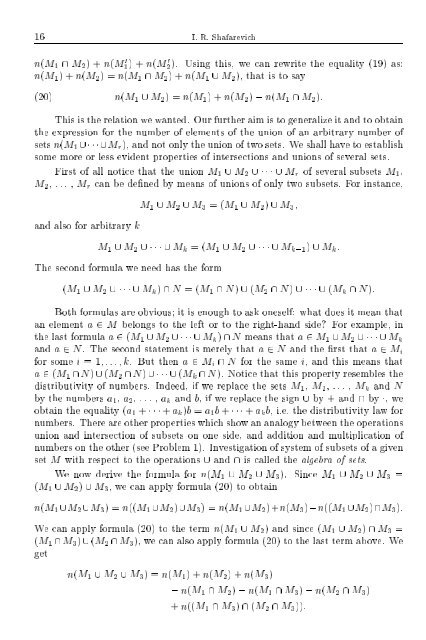SELECTED CHAPTERS FROM ALGEBRA I. R. Shafarevich Preface
SELECTED CHAPTERS FROM ALGEBRA I. R. Shafarevich Preface
SELECTED CHAPTERS FROM ALGEBRA I. R. Shafarevich Preface
Create successful ePaper yourself
Turn your PDF publications into a flip-book with our unique Google optimized e-Paper software.
16 I. R. <strong>Shafarevich</strong>n(M 1 \ M 2 )+n(M 0 1)+n(M 0 2). Using this, we can rewrite the equality (19) as:n(M 1 )+n(M 2 )=n(M 1 \ M 2 )+n(M 1 [ M 2 ), that is to say(20) n(M 1 [ M 2 )=n(M 1 )+n(M 2 ) ; n(M 1 \ M 2 ):This is the relation wewanted. Our further aim is to generalize it and to obtainthe expression for the number of elements of the union of an arbitrary number ofsets n(M 1 [[M r ), and not only the union of two sets. We shall have to establishsome more or less evident propertiesofintersections and unions of several sets.First of all notice that the union M 1 [ M 2 [[M r of several subsets M 1 ,M 2 ,...,M r can be dened by means of unions of only two subsets. For instance,and also for arbitrary kM 1 [ M 2 [ M 3 =(M 1 [ M 2 ) [ M 3 M 1 [ M 2 [[M k =(M 1 [ M 2 [[M k;1 ) [ M k :The second formula we need has the form(M 1 [ M 2 [[M k ) \ N =(M 1 \ N) [ (M 2 \ N) [[(M k \ N):Both formulas are obvious it is enough to ask oneself: what does it mean thatan element a 2 M belongs to the left or to the right-hand side? For example, inthe last formula a 2 (M 1 [ M 2 [[M k )\N means that a 2 M 1 [ M 2 [[M kand a 2 N. The second statement is merely that a 2 N and the rst that a 2 M ifor some i =1 ...k. But then a 2 M i \ N for the same i, and this means thata 2 (M 1 \ N)[(M 2 \ N)[[(M k \ N). Notice that this property resembles thedistributivity ofnumbers. Indeed, if we replace the sets M 1 , M 2 , ... , M k and Nby thenumbers a 1 , a 2 ,...,a k and b, ifwe replace the sign [ by +and\ by , weobtain the equality (a 1 ++ a k )b = a 1 b ++ a k b, i.e. the distributivity lawfornumbers. There are other properties which show an analogy between the operationsunion and intersection of subsets on one side, and addition and multiplication ofnumbers on the other (see Problem 1). Investigation of system of subsets of a givenset M with respect to the operations [ and \ is called the algebra ofsets.We now derive the formula for n(M 1 [ M 2 [ M 3 ). Since M 1 [ M 2 [ M 3 =(M 1 [ M 2 ) [ M 3 ,we can apply formula (20) to obtainn(M 1 [M 2 [M 3 )=n((M 1 [M 2 )[M 3 )=n(M 1 [M 2 )+n(M 3 );n((M 1 [M 2 )\M 3 ):We can apply formula (20) to the term n(M 1 [ M 2 ) and since (M 1 [ M 2 ) \ M 3 =(M 1 \ M 3 )[(M 2 \ M 3 ), we can also apply formula (20) to the last term above. Wegetn(M 1 [ M 2 [ M 3 )=n(M 1 )+n(M 2 )+n(M 3 ); n(M 1 \ M 2 ) ; n(M 1 \ M 3 ) ; n(M 2 \ M 3 )+ n((M 1 \ M 3 ) \ (M 2 \ M 3 )):
















